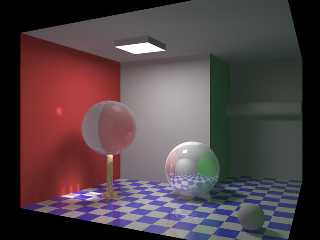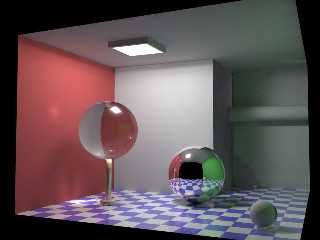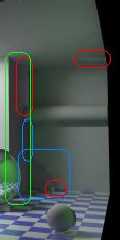 |
 |
|
 |
|
 |
|  |
|  |
|
 |
From: Ari-Matti Leppaenen
Subject: Re: Cornell's box; MegaPOV vs. WinOSi
Date: 30 Aug 2003 17:15:07
Message: <3f5113db@news.povray.org>
|
|
 |
|  |
|  |
|
 |
Hugo Asm wrote:
>>That's how I did a no-lights version of this scene last winter.
>
>
> I can't find it...?
Didn't post it. :) Actually haven't been here or poved that much since..
dunno.. at least year and I've totally lost the little touch I had. :(
How many photons are you using? I tried to add photons, but can't find a
good spacing to get rid of the splotches.
A-M
Post a reply to this message
|
 |
|  |
|  |
|
 |
|
 |
|  |
|  |
|
 |
> How many photons are you using?
Very few. They are shot during render pass 1. All lights but one has been
removed from this pass, to speed up photon calculation there is only one,
strong light at the lit plate on the ceiling.
During pass 2 (radiosity calculation) there are a grid of 4*4 area_lights at
the ceiling, to fill the room with something that resembles the physical
dimension of the lit plate. All of these lights are weak but together they
generate as much light as pass 1. However this grid of weak lights would
generate splotchy photons (no matter what I do) not to mention slow down the
process. So photons are turned off here.
Pass 3 combines the precalculated photons and radiosity, with high quality
AA, and turns on most reflections including blurred reflections on the
floor.
> I tried to add photons, but can't find a
> good spacing to get rid of the splotches.
To be precise, it's:
photons {
spacing 0.01
autostop 0
}
And the scene geometry is small. The overall bounding box is circa 4*4
units.
Regards,
Hugo
Post a reply to this message
|
 |
|  |
|  |
|
 |
From: Ari-Matti Leppaenen
Subject: Re: Cornell's box; MegaPOV vs. WinOSi
Date: 31 Aug 2003 10:58:05
Message: <3f520cfd@news.povray.org>
|
|
 |
|  |
|  |
|
 |
This is my try with POV3.5. Radiosity values are saved first from a
diffrent camera position and a super wide FOV to get most of the room
visible and then the final with photons, loadedradiosity values and
no_image for the front and right walls. The lighting is still a bit
darker and material don't look quite the same, but at least now I'm
starting to remember how to use POV.
A-M
Post a reply to this message
Attachments:
Download 'winosi.jpg' (29 KB)
Preview of image 'winosi.jpg'

|
 |
|  |
|  |
|
 |
|
 |
|  |
|  |
|
 |
Nice, but it still lacks something. :o) Anyway, how did you convert the
scene to POV? The WinOSi homepage offers the file in vmd, dxf and rib
format, and I tried at least 6 different converters but none of them worked,
so I had to rewrite the scene in POV myself (based on the vmd file). The
camera orientation and up-vector was about to drive me crazy.
> Radiosity values are saved first from a diffrent camera
> position and a super wide FOV to get most of the room visible
Could you elaborate on that?
You also said, you had a "no light" scenario, but I suppose you did use
light_sources to calc photons, right?
Regards,
Hugo
Post a reply to this message
|
 |
|  |
|  |
|
 |
|
 |
|  |
|  |
|
 |
Hugo Asm wrote:
> Anyway, how did you convert the scene to POV?
I also wrote the scene based on the vmd. The catch is that it's a right
handed system and z-axis points up and not into the screen. Also the
angle has to be a bit larger than 42 degrees.
>>Radiosity values are saved first from a diffrent camera
>>position and a super wide FOV to get most of the room visible
>
> Could you elaborate on that?
The cameras look like this:
#if( save_rad )
camera {
location <0.0, -0.01, 1.25>
look_at <0.13, -1.14, 1.25>
sky <0.00, 0.00, 1.00>
right -(4/3)*x
angle 175.0
}
#else
camera {
location <-1.27, 3.00, 1.25>
look_at <0.33, -0.14, 1.25>
sky <0.00, 0.00, 1.00>
right -(4/3)*x
angle 55.0
}
#end
> You also said, you had a "no light" scenario, but I suppose you did use
> light_sources to calc photons, right?
Yes, this one has a light_source. Earlier this year I tried an ambient
box for the lighting.
A-M
Post a reply to this message
|
 |
|  |
|  |
|
 |
|
 |
|  |
|  |
|
 |
> >Radiosity values are saved first from a diffrent camera
> >position and a super wide FOV to get most of the room visible
That's a clever trick, and I didn't expect it to work! Well, it has some
problems. The attached picture was rendered with a 90 degrees angle for
radiosity (it was too hard to adjust the camera at 175 degrees). I also
rendered radiosity at double resolution but there are definitely some
artifacts left.
> this one has a light_source. Earlier this year I tried an ambient
> box for the lighting.
And you're trying to get rid of the splotches? Well, in the image you just
posted, I think the problem is possibly the same I had: You use several
light sources at the ceiling. The easiest solution is to use only 1 light
source during photon calculation.
Regards,
Hugo
Post a reply to this message
Attachments:
Download 'illum2-d.jpg' (26 KB)
Preview of image 'illum2-d.jpg'

|
 |
|  |
|  |
|
 |
|
 |
|  |
|  |
|
 |
> Too bad no_image means no_radiosity. It would be great to be able to
> hide stuff like walls in this case and they would still affect the
> lighting.
That should be possible with
interior_texture {pigment {transmit 1}}
shouldn't it?
Mark
--
merge{#local i=-11;#while(i<11)#local
i=i+.1;sphere{<i*(i*i*(.05-i*i*(4e-7*i*i+3e-4))-3)10*sin(i)30>.5}#end
pigment{rgbt 1}interior{media{emission x}}hollow}// Mark Weyer
Post a reply to this message
|
 |
|  |
|  |
|
 |
|
 |
|  |
|  |
|
 |
> That should be possible with
> interior_texture {pigment {transmit 1}}
> shouldn't it?
I thought about it, but a quick try didn't work.
Now I might have got it to work!
It slows down rendering I'm afraid, but it works!
Thanks,
Hugo
Post a reply to this message
|
 |
|  |
|  |
|
 |
|
 |
|  |
|  |
|
 |
Hi Hugo,
There are many strange artifacts in your image -- see attached image
(only intended as a 'pointer' to your original post; red: too bright;
blue: too dark; green: gray instead of green). I don't think they are
caused by multiple light sources at the ceiling (or do they vanish
when only one light source is used?)
Sputnik
Post a reply to this message
Attachments:
Download 'illum2-d_detail.jpg' (5 KB)
Preview of image 'illum2-d_detail.jpg'

|
 |
|  |
|  |
|
 |
|
 |
|  |
|  |
|
 |
Sputnik wrote:
> There are many strange artifacts in your image -- see attached image
Thanks. Yes, you're right. These are caused by calculating radiosity in a 90
degrees camera angle, and rendering the final image with a 45 degrees angle.
Higher settings for radiosity would look nicer, but I found another solution
as Mark Weyer pointed me to: interior_texture.
Sputnik wrote:
> I don't think they are caused by multiple light sources at the
> ceiling (or do they vanish when only one light source is used?)
No, multiple light sources at the ceiling makes the photons look bad. Each
of these lights will make a bright photon-spot below the glass sphere, but
at slightly different positions. The result looks splotchy. Using only 1
light gives smooth caustics.
With all these parameters carefully adjusted, the 3 passes takes about 35
minutes to render. That's a lot quicker than joining everything in 1 pass.
WinOSi, on the other hand, need about 8 hours to make a similar, smooth
image (nearly free from noise). I checked it tonight. But there are some
advantages of WinOSi.. In short, it's more accurate.
Regards,
Hugo
Post a reply to this message
|
 |
|  |
|  |
|
 |
|
 |
|  |




![]()